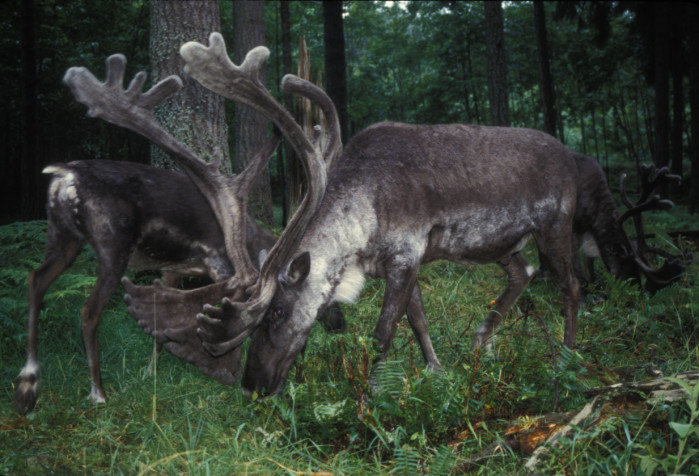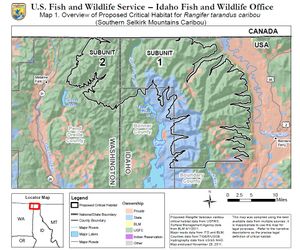Feds propose habitat protections for Selkirk caribou

ENDANGERED SPECIES -- The U.S. Fish and Wildlife Service announced Tuesday a proposal to designate 375,562 acres of critical habitat in North Idaho and northeastern Washington for southern Selkirk Mountains woodland caribou (Rangifer tarandus caribou), which are protected under the Endangered Species Act.
The action was prompted by appeals starting in 2002 by environmental groups. The action could lead to rule changes for logging, fire control and human activity in some areas. Comments on the proposal will be accepted until Jan. 30.
See comments from Forest Service on what's already being done to protect the region's caribou in today's news story.
The southern Selkirk Mountains caribou was listed as an endangered species in 1984. At last count, 46 caribou were surviving in the Selkirk Mountains of North Idaho, northeastern Washington and British Columbia.
The proposed critical habitat is located in Boundary and Bonner counties in Idaho, and Pend Oreille County in Washington. These lands are currently considered to be occupied by the species.
Read on for details from today's announcement by the U.S. Fish and Wildlife Service.
"This proposed critical habitat designation is required under the ESA, and it is the first of a two-step process. The Service seeks to gain as much information as possible from all interested parties in this step. We do encourage our federal, state and Tribal partners, and others, to provide comments specific to this proposal," said Brian Kelly, Idaho State Supervisor for the Service.
The primary threat to the species’ survival is the loss of contiguous old growth forest habitats due to timber harvest and wildfires. Human activities such as road-building and recreational trails can also fragment caribou habitat and facilitate the movement of predators into the caribou’s range.
In 1980, the Service received petitions to list the South Selkirk populations of caribou as endangered from the Idaho Department of Fish and Game and a U.S. Forest Service staff biologist. The southern Selkirk Mountains population of woodland caribou was emergency listed as endangered in northeast Washington, northern Idaho and southeast British Columbia in 1983, with a final listing in 1984.
Defenders of Wildlife, The Lands Council, Selkirk Conservation Alliance, and Center for Biological Diversity petitioned the Service to designate critical habitat for the species in 2002. A 2009 Settlement Agreement stipulated that the Service would submit a proposed critical habitat rule to the Federal Register on or before November 20, 2011, with a final rule by November 20, 2012.
The southern Selkirk Mountains caribou is a member of the deer family, and it possesses unique biological and behavioral traits. It prefers high elevations above 4,000 feet and steep terrain with old-growth forests. Small groups of mountain caribou migrate seasonally up and down mountain ranges, rather than undertaking the mass-group, long-distance migrations some species of caribou are known for. When winter snow deepens, mountain caribou feed almost exclusively on arboreal lichens that occur on old trees (typically 125 years or older), in high elevation forests.
Under the ESA, critical habitat identifies geographic areas that contain features essential for the conservation of a listed species. Critical habitat receives protection under section 7 of the ESA by requiring federal agencies to consult with the Service on federal actions that may affect critical habitat and by prohibiting federal agencies from carrying out, funding, or authorizing the destruction or adverse modification of critical habitat. Only actions that have some federal nexus are subject to consultation on critical habitat; activities undertaken by private landowners that do not involve any federal funding, permits or other activities are not affected by a critical habitat designation.
The designation of critical habitat does not affect land ownership or establish a refuge, wilderness, reserve, preserve or other conservation area. It does not allow government or public access to non-federal lands. A critical habitat designation does not impose restrictions on non-federal lands unless federal funds, permits or activities are involved. However, designating critical habitat on federal or non-federal lands informs landowners and the public of the specific areas that are important to the conservation of the species.
Comments and materials concerning this proposed rule nust be submitted by January 30, 2012. Please submit comments and other information only by one of the methods listed below. We will post your entire comment –including personal identifying information –on http://www.regulations.gov. You may request at the top of your document that we withhold personal information, such as your name, street address, phone number or e-mail address from public review; however, we cannot guarantee that we will be able to do so.
•Electronically: Go to the Federal eRulemaking Portal: http://www.regulations.gov. In the Keyword box, enter Docket No. [FWS–R1-ES-2011-0096], which is the docket number for this rulemaking. Then, in the Search panel on the left side of the screen, under the Document Type heading, click on the Proposed Rules link to locate this document. You may submit a comment by clicking on "Send a Comment or Submission."
•By hard copy: Submit by U.S. mail or hand-delivery to: Public Comments Processing, Attn: FWS–R1-ES-2011-0096; Division of Policy and Directives Management; U.S. Fish and Wildlife Service; 4401 N. Fairfax Drive, MS 2042–PDM; Arlington, VA 22203.
Please note that if you are using the Federal eRulemaking Portal, the deadline for submitting an electronic comment is 11:59 p.m. Eastern Standard Time on the closing date. We must receive requests for public hearings, in writing, by January 17, 2012. Requests must be submitted to the U.S. Fish and Wildlife Service’s Idaho Fish and Wildlife Office at 1387 S. Vinnell Way, Room 368, Boise, Idaho 83709.
Comments and materials we receive, as well as supporting documentation we used in preparing this proposed rule, are available for public inspection at http://www.regulations.gov, or by appointment during normal business hours at the Idaho Fish and Wildlife Office (address above). The proposed rule, maps and other information about the southern Selkirk Mountains caribou will also be available online at http://www.fws.gov/idaho.
For additional information, contact Bryon Holt at 509-893-8014, or by email at bryon_holt@fws.gov.
The ESA provides a critical safety net for America’s native fish, wildlife and plants, and to date has prevented the extinction of hundreds of imperiled species across the nation, as well as promoting the recovery of many others. America’s fish, wildlife and plant resources belong to all of us, and ensuring the health of imperiled species is a shared responsibility. To learn more about the Endangered Species Program, go to http://www.fws.gov/endangered.

